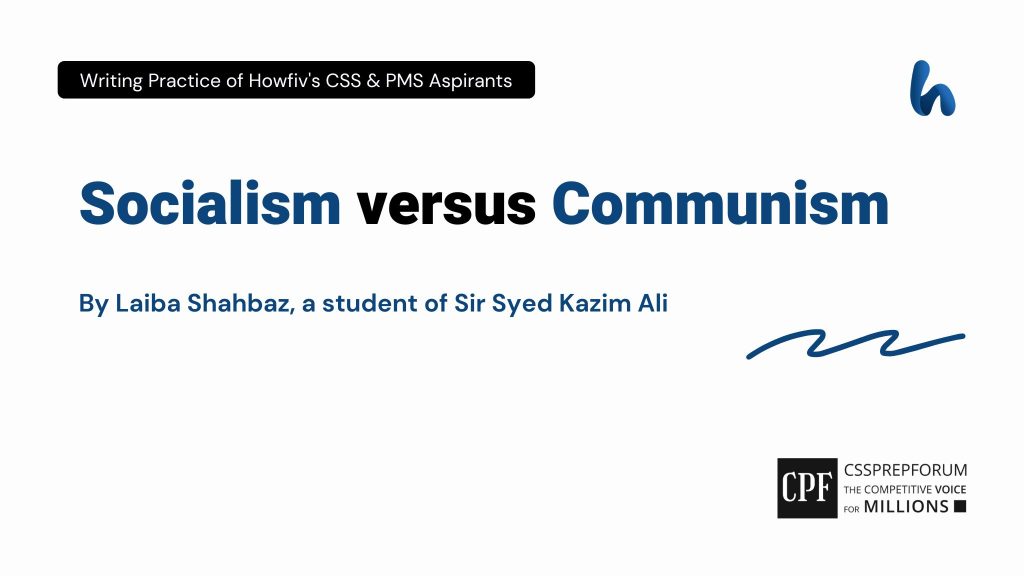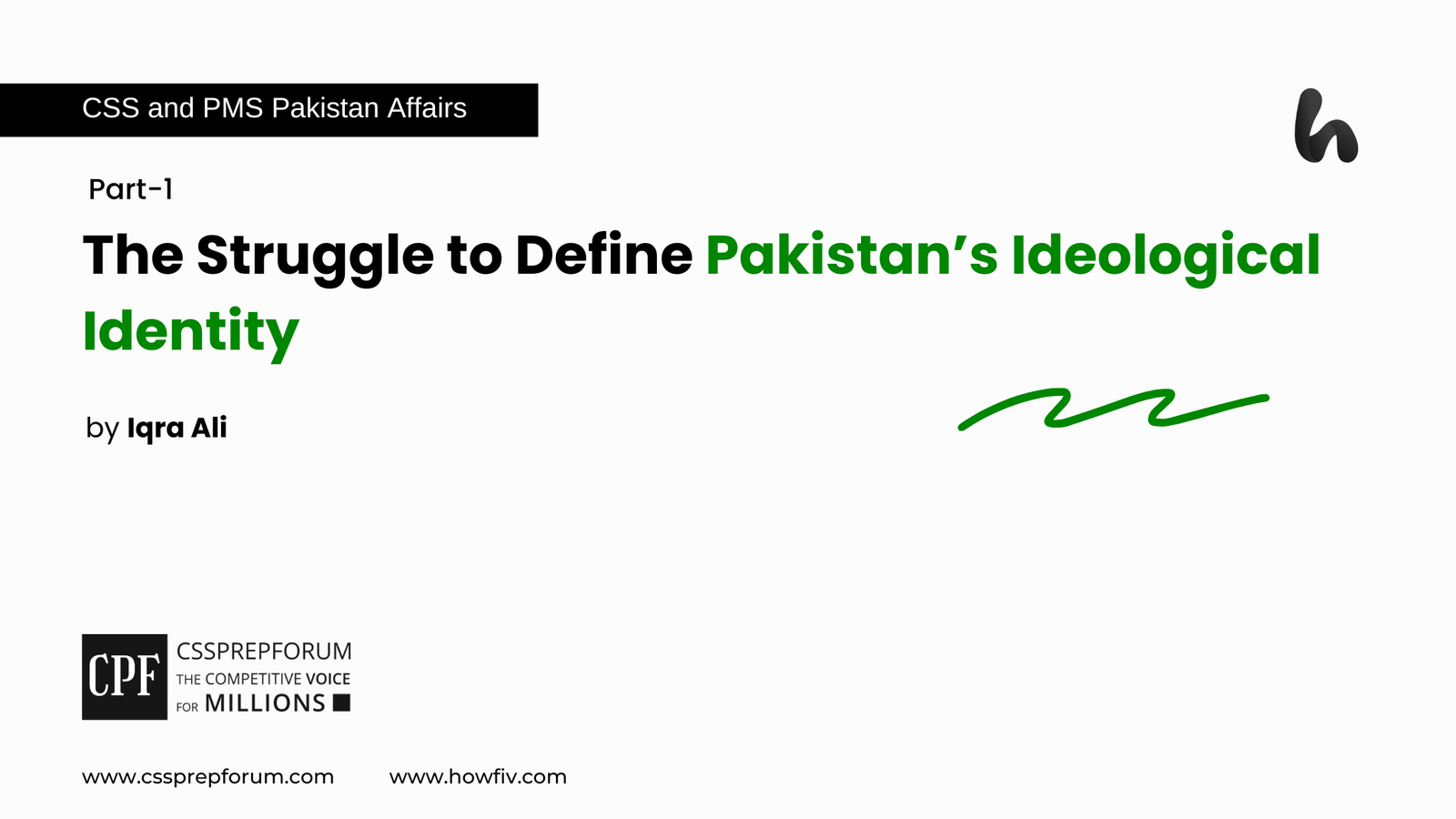Socialism versus Communism | Daily Writeup | Opinions
The following article, “Socialism versus Communism”, is written by Laiba Shahbaz, a student of Sir Syed Kazim Ali. Moreover, the article is written on the same pattern, taught by Sir to his students, scoring the highest marks in compulsory subjects for years. Sir Kazim has uploaded his students’ solved past paper questions so other thousands of aspirants can understand how to crack a topic or question, how to write relevantly, what coherence is, and how to include and connect ideas, opinions, and suggestions to score the maximum.

Outline
1-Introduction
- ✓Emerging of two ideologies in the 19th century as a rebuttal to capitalists’ social, economic, and political exploitation, socialism and communism exhibit similarities and differences, highlighting varying manifestations in contemporary economic systems, such as those of China, Sweden, and Denmark.
2-Understanding Socialism
- ✓‘From each according to his ability, to each according to his contribution’.
3-Understanding Communism
- ✓Communist Manifesto
- ✓‘From each according to his ability, to each according to his need’.
4-Historical Background
- ✓Socialism and Communism traced back to Greek thoughts when Plato wrote the ‘Republic’.
- ✓Scientifically, Karl Marx and Friedrich Engels portrayed these ideologies.
5-Similarities between Socialism and Communism
- ✓Both communism and socialism share a common origin.
- Evidence: The intellectual contributions of Karl Marx and Friedrich Engels.
- ✓Both ideologies promote some degree of collective ownership of the means of production, aiming to eliminate or minimize private ownership.
- Evidence: Prof. Hayek, in his book Road to Serfdom, has criticized the increasing role of the state in economic life as it threatens public liberty. Also, Karl Marx said, ‘the theory of communism can be summarized in one sentence: abolish any form of private property.’
- ✓Both ideologies share the vision of a classless society where social and economic disparities are reduced or eradicated.
- Evidence: Terry Eagleton, in his book ‘Ideology: An Introduction’, said, “A socialist is just someone who remains astonished that most people have endured lives of miserable, unproductive, and ceaseless labor.”
- ✓Both communism and socialism share a common criticism of capitalism, highlighting issues such as exploitation, inequality, and the potential for economic crises.
- Evidence: Malcolm X, the civil rights activist, said, “You show me a capitalist, and I’ll show you a bloodsucker”.
- ✓Both advocate for a more significant role of workers in decision-making processes within the workplace, with the shared goal of reducing hierarchical structures.
- Evidence: As Karl Marx said, “Necessity is blind until it becomes conscious. Freedom is the consciousness of necessity.”
- ✓True socialism and communism preach that everyone should be free from any religious sentiments.
- Evidence: As Karl Marx said, “Religion is the sigh of the oppressed creature, the heart of a heartless world, and the soul of soulless conditions. It is the opium of the people.”
- ✓Both ideologies are committed to international solidarity among the working class, often seeking global movements and alliances to advance their goals.
- Evidence: According to Karl Marx, “Workers of the world unite; you have nothing to lose but your chains.” “Also, let the ruling classes tremble at a communist revolution. The proletarians have nothing to lose except their chains; they have a world to win. Workingmen of all countries, unite!”
- ✓Both communism and socialism view socialism as a transitional phase towards the complete establishment of communism, where the state and classes are expected to diminish.
- Evidence: During the end of the 20th century, the USSR was in a transitional phase of socialism towards a complete classless communist society.
6-Contrast between Socialism and Communism
- ✓In socialism, the state is seen as a tool for achieving social and economic equality. While communism aspires to a stateless society where the need for a government disappears.
- Evidence: The Nordic countries, socialist states, play an active role in their economic development and provide benefits to the public. At the same time, there has never been a stateless communist society throughout history.
- ✓Socialism allows for a mix of public and private ownership of the means of production, emphasizing collective or state ownership in key industries. Conversely, communism advocates for complete collective ownership of the means of production, aiming for a classless, stateless society.
- Evidence: In the USSR, Lenin and Stalin worked towards the collective ownership of means of production under the state’s control, while socialist states like Britain allow for both public and private ownership.
- ✓Socialism has embraced its modifications, which include religious sentiments, whereas communism has been against religious affiliations.
- Evidence: The existence of Christian socialism, Buddhist socialism or Islamic socialism
- ✓Socialism seeks to reduce class disparities but may tolerate some level of inequality. At the same time, communism aims to eliminate all social classes, creating a genuinely classless society.
- Evidence: The USSR adopted an utterly classless society; today, Nordic states have some class differences between workers and owners.
- ✓Socialism is considered a transitional phase towards communism, with a more active role for the state. Communism is the final stage after socialism when the state withers away.
- Evidence: The USSR, being a socialist state, as observed by its name, never became a complete classless communist society.
- ✓Socialism talks about ‘To each according to his contribution’ while communism is about ‘to each according to his need.’
- Evidence: Nordic countries like Sweden, Norway, and Denmark have implemented social welfare programs that combine socialist principles with market economies.
- ✓Socialism can exist nationally without the immediate goal of a global revolution; instead, it seeks changes and reforms through democratic processes. Communism advocates for an international revolution and the establishment of communism worldwide.
- Evidence: The Communist USSR spread its ideology in neighbouring states in Europe and Asia, which led to war in states like Vietnam and Afghanistan. On the other hand, today’s socialist states, like Denmark, never propagate socialism externally.
- ✓Socialism today exists with modifications in different states; similarly, communism is not present anywhere in its actual form.
- Evidence: According to Britannica, today, Communism is the official form of government in five states: China, North Korea, Laos, Cuba, and Vietnam. Democratic socialism in the UK and 19th-century Syndicalism, a form of socialism in France, are examples of socialism.
7-Case Studies
- ✓Nordic socialist states
- ✓The Communist states of China, North Korea, and Cuba
8-Conclusion

Answer to the question
To give meaning to life and to solve social, political, and economic problems, human beings have created different ideas and established various philosophical thoughts. For example, ‘Socialism’ and ‘Communism’ emerged as powerful ideologies in response to the injustices and inequalities perpetuated by capitalism. Begun in the 19th century as a critique of the exploitation of the working class, these economic systems have evolved into distinct ideologies with their principles and goals. Despite their similarities, they also show significant differences in their approaches to achieving a more equitable society. Today, these ideologies can be seen in the social, political and economic systems of China, North Korea, Norway, Sweden, and many others. This article will explore the fundamental concepts of socialism and communism, highlighting their historical backgrounds, similarities, differences, and case studies of countries that have implemented these ideologies to varying degrees.
“Ideology… is indispensable in any society if men are to be formed, transformed and equipped to respond to the demands of their conditions.”
Louis Althusser
Moving ahead, socialism and communism are social, political, and economic ideologies that aim to eradicate societal inequality. To begin with the understanding of socialism, it has been presented in various forms by different schools of thought. Other types of socialism are democratic socialism, Guild socialism, Syndicalism, Utopian socialism, State socialism, Libertarianism, Green socialism, Christian socialism and Fabian Socialism. Every version of the ideology highlights the defects of the contemporary economic system and suggests solutions. This explains why different countries have different forms of socialism, even though they all say they firmly believe in the pristine ideas of Marxism. Basically, socialism can be summed up as “From each according to his ability, to each according to his contribution“. Today, socialism is applied in many states with different connotations and combinations of other ideas. For example, Norway, Sweden, and Denmark have socialism and capitalism while China, Cuba, Vietnam, Russia, and North Korea combine socialism with communism. States like Algeria, Bangladesh, Angola, India, Portugal, Sri Lanka, Mozambique and Tanzania are socialist in their constitution. Ireland, France, Great Britain, the Netherlands, and New Zealand are all strongly socialist. Hence, despite the variations, socialism is a thought and a movement that aims to mobilize all the means of production in the general interest of society.
In contrast, communism as a social, political, and economic philosophy also struggles to create greater equality by eliminating private property. Communism, a philosophy, is based on the mutual ownership of all property and the equitable distribution of wealth among the population. In particular, it demanded that the proletariat, or working class, take the authority over the means of production, such as manufacturing and agriculture. Socialism is a stage in progress toward a class society, the ultimate goal of communist ideology, after which the state and government will be abolished. In 1848, Friedrich Engels and Karl Marx published their paper ‘Communist Manifesto’, which is still influential today, focusing on a classless and stateless society. The basic principle of communism is ‘from each according to his ability, to each according to his need’. Today, no proper form of communism exists; some states still follow various forms of communism, such as China, North Korea, Vietnam, and Cuba. Thus, both, socialism and communism, aim to achieve equality by getting rid of private property. Socialism is a step towards a classless society while communism envisages a classless society.
Historically, socialism has its roots in the philosophy of ancient Greece. Plato, in his book ‘Republic’, discusses the philosophy of Communism, which is a distinct form of contemporary socialism. Plato applied the principles of communism only to the rulers while Karl Marx used it to the whole society. During the eighteenth century, many laborers began to recognize that they were being mistreated. They were motivated by socialist ideas and started fighting for better rights and working conditions, leading to the rise of confrontations between wealthy capitalists and the poor working class. In states like Britain, they called for liberal reforms and extension of voting rights. Socialist movements gained significant traction in economically developed states, like Germany, Italy, and France, as workers were more stable and organized in these nations than others. On the other hand, the USSR and China have been fully communist states; the former during Lenin and Stalin’s era and the latter during Mao’s.
Also Karl Marx and Frederick Engels scientifically portrayed socialism and communism in two still notable books ‘Das Kapital’ and ‘Communist Manifesto’. In the former, Marx presented ‘The theory of the world proletarian revolution’ and predicted its success. At the same time, in the latter, he elaborated his Socialistic doctrines and his theory of ‘Surplus Value’. Lastly, in his work, Karl Mark analyzed history, devised plans of action for the present, and predicted the future.
After understanding communism and socialism from a historical background, the similarities and differences between socialism and communism will be analyzed to illustrate further. First, both ideologies belong to the exact origin as both derive their roots from “Das Kapital” and “Communist Manifesto” by the authors Karl Marx and Friedrich Engels. Both criticized the capitalist system and exposed the exploitation of the working class. Finally, Marx’s obsession with historical materialism and class struggle formed the theoretical framework that shaped these ideologies, and, in turn, socialist and communist movements globally.
Second, both socialism and communism promote the idea of collective ownership of the means of production to eliminate private ownership. Professor Hayek, in his renowned book “The Road to Serfdom”, expressed concerns about the growing involvement of the state in economic matters and warned that it could threaten individual liberties. Similarly, Karl Marx summarized ‘The theory of Communism’ as “Abolish any kind of private property“. Thus, according to these ideologies, the state would own resources such as factories, agricultural lands, and properties.
Third, both ideologies, socialism and communism, aim to eliminate social and economic disparities and establish a society without class divisions. Terry Eagleton highlights this shared goal in his book “Ideology: An Introduction” where he said, “A Socialist is simply someone who remains surprised that so many people have beard lives filled with miserable, unproductive and constant labor.” According to the supporter of these theories, capitalism creates a class conflict between capital and labor: capitalists make more profits while workers face exploitations. Ultimately, it leads to divisions between various classes. Hence, these ideologies aim to save a society from class divisions by eliminating classes.
Fourth, both socialism and communism criticize capitalism, pointing to its built-in flaws, such as inequality, exploitation, and sensitivity, to economic crises. Civil rights activist Malcolm X expressed capitalists as exploiters in his statement, “You show me a capitalist, and I’ll show you a bloodsucker.“ Proponents of these ideologies believe that the capitalist system puts profit before people, causing the alienation and suffering of the working class. Hence, to deal with the structural inequality that capitalism propagates, socialism and communism highlight these concerns and promote alternative economic systems that prioritize shared ownership, social development, and equitable allocation of resources.
Fifth, socialism and communism encourage employees to participate more in corporate decision-making to reduce hierarchal structures and strengthen the labour force. Karl Marx once said, “Necessity is blind until it becomes conscious. Freedom is the consciousness of necessity”. It depicts the importance of employees understanding their strength, which lies in their group and their capacity to direct their destinies. Therefore, both ideas question traditional hierarchical governance structures in the workplace and promote a more democratic and inclusive approach to worker relations by highlighting workers’ significance in decision-making.
Sixth, both ideologies advocate for the liberation of people from all kinds of religious affiliations because proponents of these ideologies see religion as a tool for oppression and a product of socio-economic condemnation. This could be understood by the quotation of the founder of these ideologies, Karl Mark, who said, “Religion is the sigh of the oppressed creature, the heart of a heartless world, and the soul of soulless conditions. It is the opium of the people.” He thought that religion acts as a control mechanism in society, which provides comfort to the oppressed people and diverts attention away from the worldly realities of society. Hence, according to the proponents of genuine socialism and communism, society would be promoted based on equality, reason, and the quest for collective freedom by calling for eliminating religious influences.
Seventh, to achieve their goals, socialism and communism strongly emphasize the necessity of unity among the working class and support international alliances and activities globally. Karl Marx encapsulated it as “Workers of the world unite; you have nothing to lose but your chains.” Also he believed in the revolutionary potential of communism and demanded that proletariats globally unite in solidarity, as he said, “Let the ruling classes tremble at a communist revolution. The proletarians have nothing to lose except their chains. They have a world to win. Workingmen of all countries, unite!” Thus, communism and socialism emphasize the belief that collective action is required for the freedom of the working class globally.
Eight, both communism and socialism view socialism as a transitional phase towards the complete realization of communism that the dissolution of state and class divisions can characterize. During the twentieth century, the Soviet Union attempted to build a classless society where no one would own any form of property. Only the state would own all the property until the fulfilment of a completely classless communist society, which would dissolve the government or ruling elite of the state automatically. The USSR has never been a communist state as it has always been in a transitional phase towards an utterly communist society; it is also depicted by its name, the United Soviet Socialist Republic. The government was responsible for resource allocation and economic planning in such a transitional phase. Therefore, it shows the agreement of both ideologies on socialism as a transitional phase towards a complete communist society.
After understanding the similarities, the contrast between the two theories will now be discussed. First, as a precursor towards a communist stateless society, socialism has perceived by the state as a means to attain equality, justice, and development in all domains of life. For example, in a socialist and capitalist state, the government takes care of people’s social and political rights and provides free services and benefits. According to the United Nations reports, Norway ranked 1st in the Human Development Index 2018. Similarly, in the Global Competitiveness Index, Sweden, Finland, Denmark, and Norway ranked in the top positions. Conversely, communism imagines a stateless society where the need for government is unnecessary. Historically, there has never been a stateless communist society. Thus, communism and socialism differ in the use and need of the state for a society.
Second, in socialism, means of production are owned by both public and private sectors while the state could own crucial industries and institutions for the well-being of the state. On the other hand, communism is the staunch supporter of eliminating private property. According to the proponents of communism, all properties would be owned by the government for a particular period until a state collapsed. In history, it has been evident that during Lenin and Stalin, in the USSR, the state controlled all resources and decided their allocation. But they never again lose state control owing to personal greed, leading to a tense and troubled society. In contrast, socialist states, such as Britain, allow private and public ownership, a more flexible approach towards economic development. Hence, the ownership of resources, whether by the people or the state, decides the course of the future of a nation.
Third, socialism has expanded to include religious sentiments, as evidenced by the rise of movements, like Islamic socialism, Buddhist socialism, and Christian socialism. Conversely, communism rejected religious affiliations and opposed religious practices and influences. They think religion is a tool of the oppressor class, and it distracts proletarians from class struggle. In the USSR, during the first decades of the revolution in 1917, several monasteries and churches were destroyed. Many clergymen were killed and forced into exile. During the 1930s, much of the industrialization came from assets confiscated from the Church. Thus, the main difference between socialism and communism is the permissibility and prohibition of the practice of religion.
Fourth, socialism has been a much more moderate ideology than communism. This can be evident in policies and their implementation of both ideologies. Socialism seeks to decrease class differences to the lowest extent while communism aims to eliminate such disparities and inequality. For example, during the peak of the communist era in the USSR, in the latter half of the twentieth century, Lenin and Stalin attempted to create a classless society with an equal division of work in all segments of society and the same economic conditions. In the socialist Nordic states, economic differences exist that led to the creation of social classes. Therefore, socialism can bear injustice while communism cannot.
Fifth, according to the founders of these ideologies, socialism has been a transitional phase towards a completely classless and stateless society. Conversely, after the transitional phase of socialism, the ultimate stage of communism will be achieved, where no class and society will exist. In history, there has never been a fully-fledged communist state. Whatever exists was just the transitional phase of communism, which is socialism. For example, the USSR, the most outstanding pioneer of communism, was itself a socialist state. Therefore, socialism is just a precursor towards communism.
Sixth, one of the essential differences between Communism and Socialism is in their motto; Communism demonstrates, “To each according to his need,” and Socialism debates, “To each according to his contribution”. These slogans are enough to understand the thinking of both ideologies. Communism is a strict ideology that only serves people when they need it while socialism is a moderate ideology, which gives people according to how much they contribute. For example, in the communist USSR, all had to do immense work in strict working conditions, and they received very minimum as a result. In Nordic states, the government pays according to the people’s contribution and serves them through various socialist programs. Hence, communism does not care about the needs of the people while socialism does. Ironically, despite talking about bringing justice to society, communism pays wages according to the need and contrarily forces people to do excessive work, which is also an injustice to the people.
Seventh, socialism can exist at the national level without the immediate goal of worldwide revolution; alternatively, it may pursue adjustments and modifications via democratic channels. Communism advocates global revolution and the establishment of communism worldwide. For example, the Communist USSR spread its ideology in neighbouring states in Europe and Asia, leading to wars in states, like Vietnam and Afghanistan. On the other hand, today’s socialist states, like Denmark, never propagate socialism externally. So, communism has a higher purpose, like spreading its ideology externally, while socialism does not.
Eighth, socialism exists with modifications in different states whereas pure communism is not actively practiced anywhere. For instance, according to Britannica, today, Communism is the official form of government in five states: China, North Korea, Laos, Cuba, and Vietnam. The democratic socialism of the UK and 19th-century Syndicalism, a form of socialism in France, are examples of socialism. Therefore, these examples highlight the varied expressions of global socialism, while communism is primarily associated with past and present authoritarian regimes.
Further, case studies of socialist and communist states will be studied to understand the impact of the two different ideologies on the functioning of the state. Many states of the world have attempted to incorporate the fundamentals of these ideologies in their systems, but no state has been purely Socialist or Communist. Still, some states have adopted socialism with some modifications. For example, in the case of Nordic states, Norway, Sweden and Denmark, the democratically elected government serves the people with free education, health care, and post-retirement funds. As a result, people pay the highest taxes in the world. With it, these states also have booming capitalist sectors, a reservoir of wealth. Thus, such states have an amalgamation of both socialist and capitalist systems.
Contrarily, there has never been an actual communist state. Many nations that Communist Party leads identify as socialist governments and implement socialist policies. Today, three states are considered communist states: China, Cuba, and North Korea. First, in China, the Communist Party has strictly controlled all sectors of the states and successfully generated profits for the government from the export of consumer goods. The government provides health care and education facilities while the housing and property sectors operate under a competitive capitalist class. Second, the Communist Party of Cuba has tight control over most state sectors. People also work for the state. Third, like other states, North Korea was ruled under the tight control of the Communist Party until 1946, after which the state now operates under the “Socialist Constitution of the Democratic People’s Republic of Korea.” However, the government has a strong hold over most sectors. The government controls workers, farmlands, and food distribution. Private ownership is not allowed; the government issues the right to public housing. With it, the government also provides health and education facilities. Thus, the Communist system has left its footmarks in some states.
To conclude, socialism and communism arose in response to capitalism’s inequality, promotion of communal ownership of resources, and closing of social gaps. Socialism often involves state involvement and a combination of public and private ownership, while communism envisions a society without the state and full communal ownership. Despite their shared goals of equality and justice, their methods and executions differ, reflecting the complexities of solving social problems. Both theories have diverse historical and contemporary examples worldwide, each with distinct interpretations.

CSS Solved Past Papers’ Essays
Looking for the last ten years of CSS and PMS Solved Essays and want to know how Sir Kazim’s students write and score the highest marks in the essays’ papers? Then, click on the CSS Solved Essays to start reading them.
CSS Solved Essays
CSS Solved General Science & Ability Past Papers
Want to read the last ten years’ General Science & Ability Solved Past Papers to learn how to attempt them and to score high? Let’s click on the link below to read them all freely. All past papers have been solved by Miss Iqra Ali & Dr Nishat Baloch, Pakistan’s top CSS GSA coach having the highest score of their students. General Science & Ability Solved Past Papers












